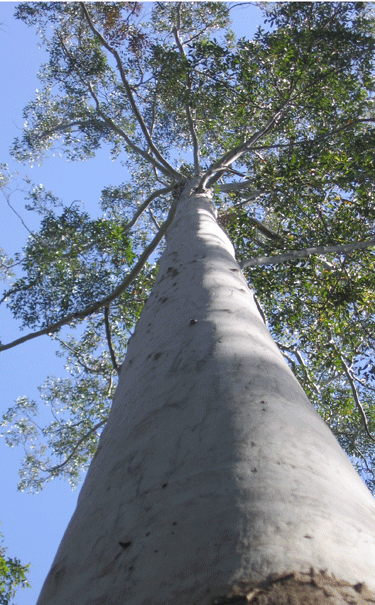
The flooded gum originated on the east coast of Australia. Photo: M. Shepherd
The flooded gum (Eucalyptus grandis) has become the second forest tree in the world to have its genome sequenced.
Eucalypts are the most popular plantation trees in the world and are now grown on every continent for paper pulp. It is also used for solid wood and recently as a biofuel crop in the Americas.
“Everyone is interested in eucalyptus because they’re such a versatile tree,” said Professor William Foley, a plant geneticist from the Australian National University in Canberra and one of the participants in the study.
To map the flooded gum’s genome, the international team of scientists used a process called shotgun sequencing. “We busted it up into lots of little pieces and then reassembled it like a jigsaw,” said Professor Foley.
There are approximately 800 species of Eucalyptus trees. But in spite of this wide variety among the species, they are genetically quite similar.
Eucalypts diversified in Australia 15-18 million years ago but have been present on the continent much longer. The size of the genome of the sequenced species, Eucalyptus grandis, is average in the plant kingdom with about 600 million letters of code, one-fifth the length of the human genome.
The Tasmanian Blue Gum genome, which has been partially mapped, only contains 480 million letters of code. In comparison, the genome of pines contains about 30,000 million and is yet to be sequenced.
The eucalyptus’ short genome is due to the lack of transposable elements- the remnants of viral DNA that would have accumulated during their evolution and added extra information to the genome. Professor Foley says the few changes that have occurred can show scientists how genomes evolve, what causes them to gain extra information and what the consequences are.
Since their arrival, Eucalypts have adapted to living in a wide range of conditions throughout Australia. One example is the Forest Red Gum, which grows across diverse climates from Cape York to Gippsland.
The variations within the genome will enable scientists to understand which species can grow under different conditions and where they should be planted for future conservation. Professor Foley said understanding this “helps us select the right tree in the right place for the future.”
Scientists will also use the genome to help identify why some species are resistant to diseases such as Myrtle Rust, which originated in South America. Cases of myrtle rust were discovered on the NSW’s central coast in 2010 and have since spread north to Cairns and south to Victoria.
“(It’s) a disease that could potentially wipe out the eucalyptus and its relatives in Australia,” Professor Foley said. “We have to guard for all these unexpected things that are going to happen.”






